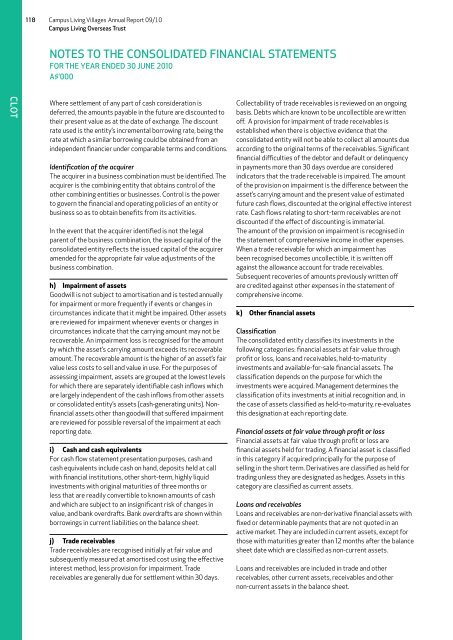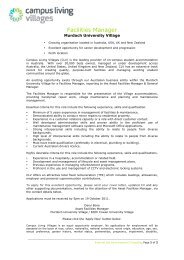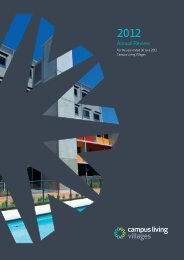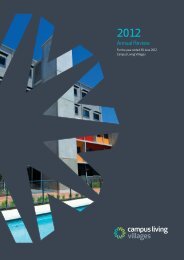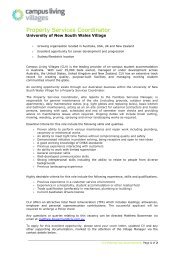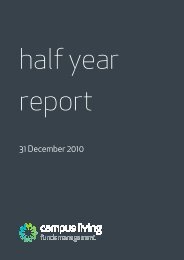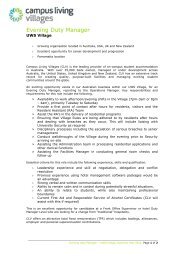Annual Report - Campus Living Villages
Annual Report - Campus Living Villages
Annual Report - Campus Living Villages
You also want an ePaper? Increase the reach of your titles
YUMPU automatically turns print PDFs into web optimized ePapers that Google loves.
1 1 8 <strong>Campus</strong> <strong>Living</strong> <strong>Villages</strong> <strong>Annual</strong> <strong>Report</strong> 09/10<br />
<strong>Campus</strong> <strong>Living</strong> Overseas Trust<br />
NOTES TO THE CONSOLIDATED FINANCIAL STATEMENTS<br />
FOR THE YEAR ENDED 30 JUNE 2010<br />
A$’000<br />
CLOT<br />
Where settlement of any part of cash consideration is<br />
deferred, the amounts payable in the future are discounted to<br />
their present value as at the date of exchange. The discount<br />
rate used is the entity’s incremental borrowing rate, being the<br />
rate at which a similar borrowing could be obtained from an<br />
independent financier under comparable terms and conditions.<br />
Identification of the acquirer<br />
The acquirer in a business combination must be identified. The<br />
acquirer is the combining entity that obtains control of the<br />
other combining entities or businesses. Control is the power<br />
to govern the financial and operating policies of an entity or<br />
business so as to obtain benefits from its activities.<br />
In the event that the acquirer identified is not the legal<br />
parent of the business combination, the issued capital of the<br />
consolidated entity reflects the issued capital of the acquirer<br />
amended for the appropriate fair value adjustments of the<br />
business combination.<br />
h) Impairment of assets<br />
Goodwill is not subject to amortisation and is tested annually<br />
for impairment or more frequently if events or changes in<br />
circumstances indicate that it might be impaired. Other assets<br />
are reviewed for impairment whenever events or changes in<br />
circumstances indicate that the carrying amount may not be<br />
recoverable. An impairment loss is recognised for the amount<br />
by which the asset’s carrying amount exceeds its recoverable<br />
amount. The recoverable amount is the higher of an asset’s fair<br />
value less costs to sell and value in use. For the purposes of<br />
assessing impairment, assets are grouped at the lowest levels<br />
for which there are separately identifiable cash inflows which<br />
are largely independent of the cash inflows from other assets<br />
or consolidated entity’s assets (cash-generating units). Nonfinancial<br />
assets other than goodwill that suffered impairment<br />
are reviewed for possible reversal of the impairment at each<br />
reporting date.<br />
i) Cash and cash equivalents<br />
For cash flow statement presentation purposes, cash and<br />
cash equivalents include cash on hand, deposits held at call<br />
with financial institutions, other short-term, highly liquid<br />
investments with original maturities of three months or<br />
less that are readily convertible to known amounts of cash<br />
and which are subject to an insignificant risk of changes in<br />
value, and bank overdrafts. Bank overdrafts are shown within<br />
borrowings in current liabilities on the balance sheet.<br />
j) Trade receivables<br />
Trade receivables are recognised initially at fair value and<br />
subsequently measured at amortised cost using the effective<br />
interest method, less provision for impairment. Trade<br />
receivables are generally due for settlement within 30 days.<br />
Collectability of trade receivables is reviewed on an ongoing<br />
basis. Debts which are known to be uncollectible are written<br />
off. A provision for impairment of trade receivables is<br />
established when there is objective evidence that the<br />
consolidated entity will not be able to collect all amounts due<br />
according to the original terms of the receivables. Significant<br />
financial difficulties of the debtor and default or delinquency<br />
in payments more than 30 days overdue are considered<br />
indicators that the trade receivable is impaired. The amount<br />
of the provision on impairment is the difference between the<br />
asset’s carrying amount and the present value of estimated<br />
future cash flows, discounted at the original effective interest<br />
rate. Cash flows relating to short-term receivables are not<br />
discounted if the effect of discounting is immaterial.<br />
The amount of the provision on impairment is recognised in<br />
the statement of comprehensive income in other expenses.<br />
When a trade receivable for which an impairment has<br />
been recognised becomes uncollectible, it is written off<br />
against the allowance account for trade receivables.<br />
Subsequent recoveries of amounts previously written off<br />
are credited against other expenses in the statement of<br />
comprehensive income.<br />
k) Other financial assets<br />
Classification<br />
The consolidated entity classifies its investments in the<br />
following categories: financial assets at fair value through<br />
profit or loss, loans and receivables, held-to-maturity<br />
investments and available-for-sale financial assets. The<br />
classification depends on the purpose for which the<br />
investments were acquired. Management determines the<br />
classification of its investments at initial recognition and, in<br />
the case of assets classified as held-to-maturity, re-evaluates<br />
this designation at each reporting date.<br />
Financial assets at fair value through profit or loss<br />
Financial assets at fair value through profit or loss are<br />
financial assets held for trading. A financial asset is classified<br />
in this category if acquired principally for the purpose of<br />
selling in the short term. Derivatives are classified as held for<br />
trading unless they are designated as hedges. Assets in this<br />
category are classified as current assets.<br />
Loans and receivables<br />
Loans and receivables are non-derivative financial assets with<br />
fixed or determinable payments that are not quoted in an<br />
active market. They are included in current assets, except for<br />
those with maturities greater than 12 months after the balance<br />
sheet date which are classified as non-current assets.<br />
Loans and receivables are included in trade and other<br />
receivables, other current assets, receivables and other<br />
non-current assets in the balance sheet.


